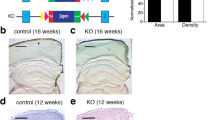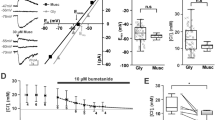Abstract
The absence of the chloride channel CLC-3 in Clcn3−/− mice results in hippocampal degeneration with a distinct temporal-spatial sequence that resembles neuronal loss in temporal lobe epilepsy. We examined how the loss of CLC-3 might affect GABAergic synaptic transmission in the hippocampus. An electrophysiological study of synaptic function in hippocampal slices taken from Clcn3−/− mice before the onset of neurodegeneration revealed a substantial decrease in the amplitude and frequency of miniature inhibitory postsynaptic currents compared with those in wild-type slices. We found that CLC-3 colocalized with the vesicular GABA transporter VGAT in the CA1 region of the hippocampus. Acidification of inhibitory synaptic vesicles induced by Cl− showed a marked dependence on CLC-3 expression. The decrease in inhibitory transmission in Clcn3−/− mice suggests that the neurotransmitter loading of synaptic vesicles was reduced, which we attribute to defective vesicular acidification. Our observations extend the role of Cl− in inhibitory transmission from that of a postsynaptic permeant species to a presynaptic regulatory element.
This is a preview of subscription content, access via your institution
Access options
Subscribe to this journal
Receive 12 print issues and online access
$209.00 per year
only $17.42 per issue
Buy this article
- Purchase on Springer Link
- Instant access to full article PDF
Prices may be subject to local taxes which are calculated during checkout







Similar content being viewed by others
References
Stobrawa, S.M. et al. Disruption of ClC-3, a chloride channel expressed on synaptic vesicles, leads to a loss of the hippocampus. Neuron 29, 185–196 (2001).
Dickerson, L.W. et al. Altered GABAergic function accompanies hippocampal degeneration in mice lacking ClC-3 voltage-gated chloride channels. Brain Res. 958, 227–250 (2002).
Yoshikawa, M. et al. CLC-3 deficiency leads to phenotypes similar to human neuronal ceroid lipofuscinosis. Genes Cells 7, 597–605 (2002).
Wang, X.Q. et al. CLC-3 channels modulate excitatory synaptic transmission in hippocampal neurons. Neuron 52, 321–333 (2006).
Maritzen, T., Keating, D.J., Neagoe, I., Zdebik, A.A. & Jentsch, T.J. Role of the vesicular chloride transporter ClC-3 in neuroendocrine tissue. J. Neurosci. 28, 10587–10598 (2008).
Schenck, S., Wojcik, S.M., Brose, N. & Takamori, S. A chloride conductance in VGLUT1 underlies maximal glutamate loading into synaptic vesicles. Nat. Neurosci. 12, 156–162 (2009).
Habela, C.W., Olsen, M.L. & Sontheimer, H. ClC3 is a critical regulator of the cell cycle in normal and malignant glial cells. J. Neurosci. 28, 9205–9217 (2008).
Cuddapah, V.A. & Sontheimer, H. Molecular interaction and functional regulation of ClC-3 by Ca2+/calmodulin-dependent protein kinase II (CaMKII) in human malignant glioma. J. Biol. Chem. 285, 11188–11196 (2010).
Juge, N., Muroyama, A., Hiasa, M., Omote, H. & Moriyama, Y. Vesicular inhibitory amino acid transporter is a Cl-/gamma-aminobutyrate co-transporter. J. Biol. Chem. 284, 35073–35078 (2009).
Gulyás, A.I., Megias, M., Emri, Z. & Freund, T.F. Total number and ratio of excitatory and inhibitory synapses converging onto single interneurons of different types in the CA1 area of the rat hippocampus. J. Neurosci. 19, 10082–10097 (1999).
Takamori, S., Riedel, D. & Jahn, R. Immunoisolation of GABA-specific synaptic vesicles defines a functionally distinct subset of synaptic vesicles. J. Neurosci. 20, 4904–4911 (2000).
Atluri, P.P. & Ryan, T.A. The kinetics of synaptic vesicle reacidification at hippocampal nerve terminals. J. Neurosci. 26, 2313–2320 (2006).
Gandhi, S.P. & Stevens, C.F. Three modes of synaptic vesicular recycling revealed by single-vesicle imaging. Nature 423, 607–613 (2003).
Zhang, Q., Cao, Y.Q. & Tsien, R.W. Quantum dots provide an optical signal specific to full collapse fusion of synaptic vesicles. Proc. Natl. Acad. Sci. USA 104, 17843–17848 (2007).
Kerr, A.M., Reisinger, E. & Jonas, P. Differential dependence of phasic transmitter release on synaptotagmin 1 at GABAergic and glutamatergic hippocampal synapses. Proc. Natl. Acad. Sci. USA 105, 15581–15586 (2008).
Edwards, R.H. The neurotransmitter cycle and quantal size. Neuron 55, 835–858 (2007).
Hnasko, T.S. et al. Vesicular glutamate transport promotes dopamine storage and glutamate corelease in vivo. Neuron 65, 643–656 (2010).
Grønborg, M. et al. Quantitative comparison of glutamatergic and GABAergic synaptic vesicles unveils selectivity for few proteins including MAL2, a novel synaptic vesicle protein. J. Neurosci. 30, 2–12 (2010).
Hell, J.W., Maycox, P.R. & Jahn, R. Energy dependence and functional reconstitution of the gamma-aminobutyric acid carrier from synaptic vesicles. J. Biol. Chem. 265, 2111–2117 (1990).
Kraushaar, U. & Jonas, P. Efficacy and stability of quantal GABA release at a hippocampal interneuron-principal neuron synapse. J. Neurosci. 20, 5594–5607 (2000).
Bartos, M., Vida, I., Frotscher, M., Geiger, J.R. & Jonas, P. Rapid signaling at inhibitory synapses in a dentate gyrus interneuron network. J. Neurosci. 21, 2687–2698 (2001).
Deriy, L.V. et al. The granular chloride channel ClC-3 is permissive for insulin secretion. Cell Metab. 10, 316–323 (2009).
Deriy, L.V. et al. Disease-causing mutations in the cystic fibrosis transmembrane conductance regulator determine the functional responses of alveolar macrophages. J. Biol. Chem. 284, 35926–35938 (2009).
Zhou, Q., Petersen, C.C. & Nicoll, R.A. Effects of reduced vesicular filling on synaptic transmission in rat hippocampal neurones. J. Physiol. (Lond.) 525, 195–206 (2000).
Klausberger, T. & Somogyi, P. Neuronal diversity and temporal dynamics: the unity of hippocampal circuit operations. Science 321, 53–57 (2008).
Huang, P. et al. Regulation of human CLC-3 channels by multifunctional Ca-/calmodulin–dependent protein kinase. J. Biol. Chem. 276, 20093–20100 (2001).
Hell, J.W. & Jahn, R. in Cell Biology. A Laboratory Handbook Vol. 1 (ed. Celis, J.E.) 567–574 (Academic, San Diego, 1994).
Maycox, P.R., Deckwerth, T., Hell, J.W. & Jahn, R. Glutamate uptake by brain synaptic vesicles. Energy dependence of transport and functional reconstitution in proteoliposomes. J. Biol. Chem. 263, 15423–15428 (1988).
Acknowledgements
We thank A. Fox, S. Takamori, R. Edwards, L. Farmer and R. Sarac for conversations, V. Bindokas and P. Toth for technical help with microscopy, Y. Chen for help with immuno-electron microscopy, and F. Lamb (Univ. Iowa) for the Clcn3−/− strain. The study was supported by NIH R01 GM36823 and NIH R01 DK 080364 to D.J.N.
Author information
Authors and Affiliations
Contributions
V.R., L.V.D. and D.J.N. designed the project, analyzed the data and wrote the manuscript. V.R, L.V.D., P.D.S., B.L. and E.A.G. performed the experiments.
Corresponding author
Ethics declarations
Competing interests
The authors declare no competing financial interests.
Supplementary information
Supplementary Text and Figures
Supplementary Figures 1–7 and Supplementary Table 1 (PDF 7515 kb)
Rights and permissions
About this article
Cite this article
Riazanski, V., Deriy, L., Shevchenko, P. et al. Presynaptic CLC-3 determines quantal size of inhibitory transmission in the hippocampus. Nat Neurosci 14, 487–494 (2011). https://doi.org/10.1038/nn.2775
Received:
Accepted:
Published:
Issue Date:
DOI: https://doi.org/10.1038/nn.2775
This article is cited by
-
Gluconate suppresses seizure activity in developing brains by inhibiting CLC-3 chloride channels
Molecular Brain (2019)
-
An interplay between plasticity and parental phenotype determines impacts of ocean acidification on a reef fish
Nature Ecology & Evolution (2017)
-
A neurocentric perspective on glioma invasion
Nature Reviews Neuroscience (2014)
-
Effects of midazolam, pentobarbital and ketamine on the mRNA expression of ion channels in a model organism Daphnia pulex
BMC Anesthesiology (2013)
-
CLC-3 spices up GABAergic synaptic vesicles
Nature Neuroscience (2011)



